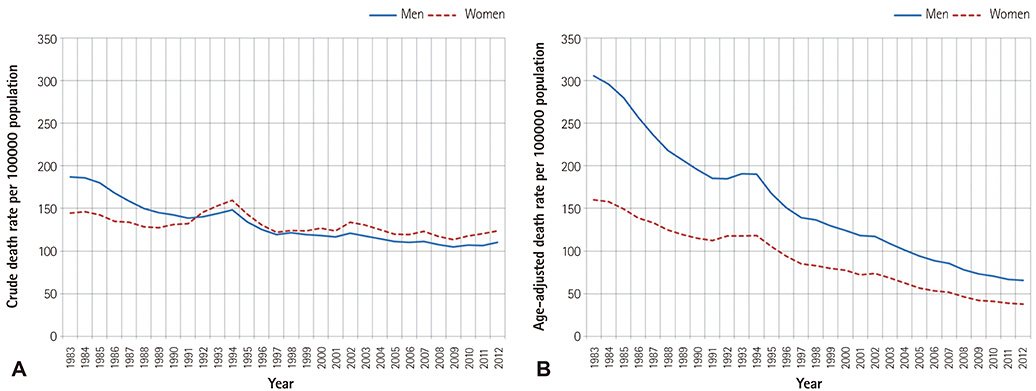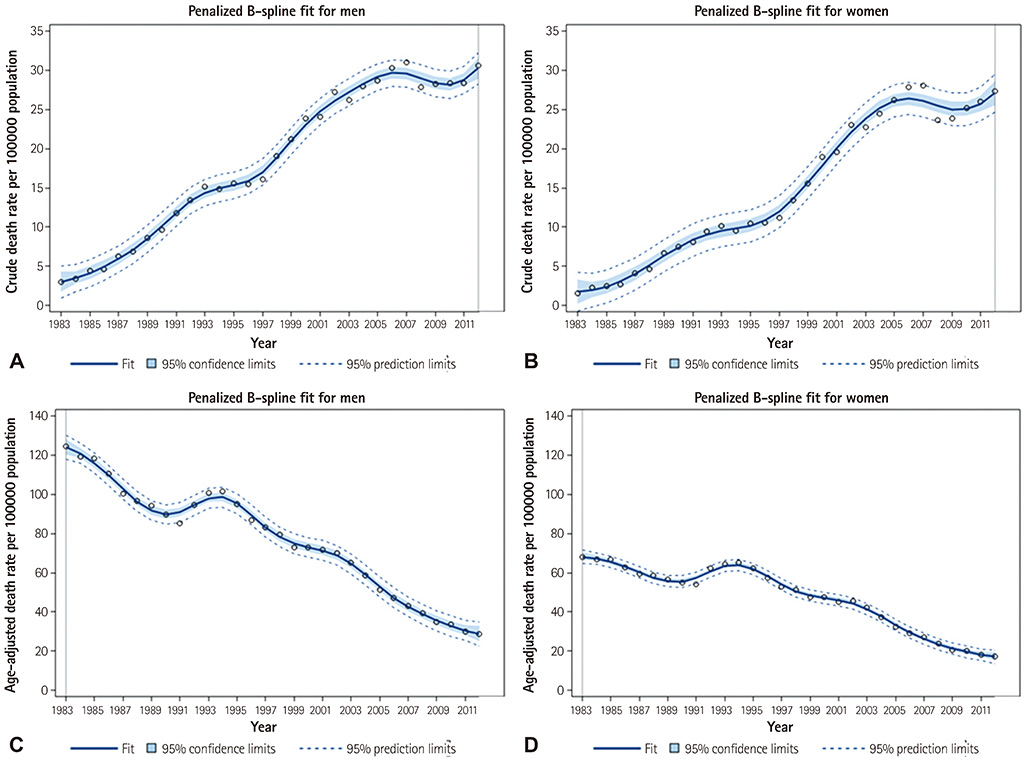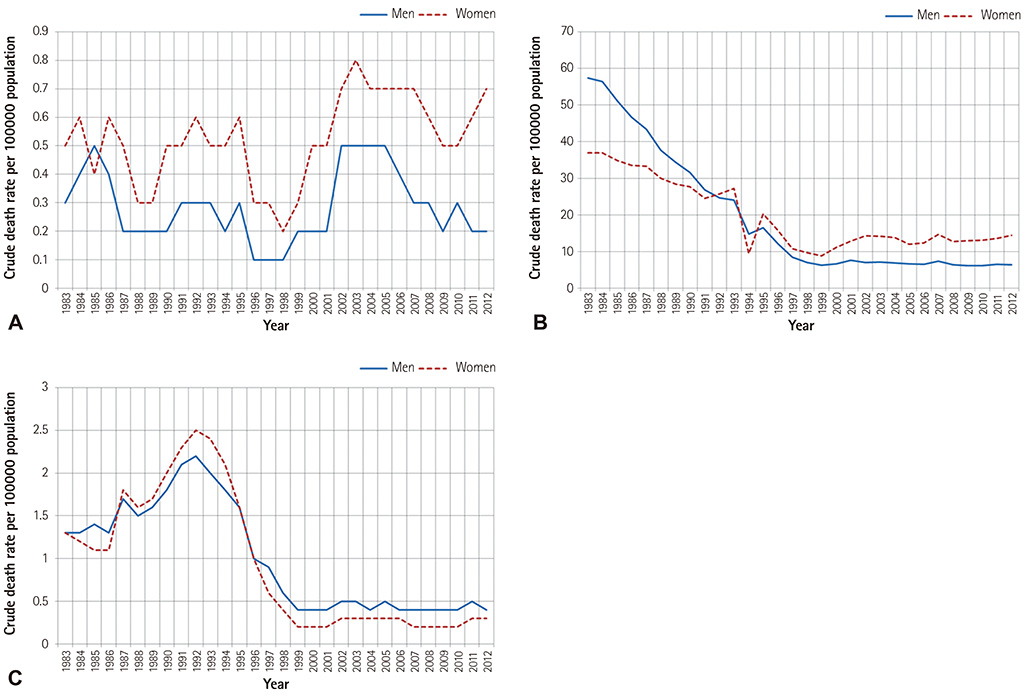Thirty-Year Trends in Mortality from Cardiovascular Diseases in Korea
- Affiliations
-
- 1Department of Public Health, Yonsei University Graduate School, Seoul, Korea.
- 2Cardiovascular and Metabolic Diseases Etiology Research Center, Seoul, Korea. hckim@yuhs.ac
- 3Department of Preventive Medicine, Yonsei University College of Medicine, Seoul, Korea.
- 4Department of Biostatistics, Yonsei University College of Medicine, Seoul, Korea.
- KMID: 2389127
- DOI: http://doi.org/10.4070/kcj.2015.45.3.202
Abstract
- BACKGROUND AND OBJECTIVES
An understanding of cardiovascular diseases (CVD) mortality is important for the development of strategies aimed at reducing the burden of CVD. Thus, we examined the changing pattern of CVD mortality in Korea over 30 years (1983-2012) by analyzing the Cause of Death Statistics.
MATERIALS AND METHODS
Deaths from diseases of the circulatory system and those of five CVD categories were analyzed: total heart diseases, acute rheumatic fever/chronic rheumatic heart disease, hypertensive heart disease, ischemic heart disease (IHD) and atherosclerosis. To assess the effects of population ageing on CVD mortality, crude and age-adjusted mortality rates were calculated. Age-adjusted mortality rates were calculated by using the direct standardization method.
RESULTS
Over the 30-year period analyzed in this study, circulatory system disease mortality markedly declined. The age-adjusted mortality rate decreased by 78.5% in men and by 76.3% in women. Consistent decreasing trends were observed for mortalities from rheumatic heart disease, hypertensive heart disease, and atherosclerosis. However, IHD mortality rapidly increased during the 30 years. Crude IHD mortality showed a steady increase until 2007, after which there were fluctuations. But the penalized regression splines showed that crude IHD mortality continued to increase. Age-adjusted IHD mortality peaked in the early 2000s, and started to decrease during the last few years.
CONCLUSION
In summary, total CVD mortality rate has significantly decreased over the 30-year period analyzed in this study but the IHD mortality rate has continuously increased until recently. The prevention and management of cardiovascular diseases amongst the Korean population, especially IHD, still represents a great challenge.
Keyword
MeSH Terms
Figure
Cited by 10 articles
-
Validation of Risk Prediction Models for Atherosclerotic Cardiovascular Disease in a Prospective Korean Community-Based Cohort
Jae Hyun Bae, Min Kyong Moon, Sohee Oh, Bo Kyung Koo, Nam Han Cho, Moon-Kyu Lee
Diabetes Metab J. 2020;44(3):458-469. doi: 10.4093/dmj.2019.0061.2020 Korean Society of Myocardial Infarction Expert Consensus Document on Pharmacotherapy for Acute Myocardial Infarction
Hyun Kuk Kim, Youngkeun Ahn, Kiyuk Chang, Young-Hoon Jeong, Joo-Yong Hahn, Eun Ho Choo, Min Chul Kim, Hyo-Soo Kim, Weon Kim, Myeong-Chan Cho, Yangsoo Jang, Chong Jin Kim, Myung Ho Jeong, Shung Chull Chae,
Korean Circ J. 2020;50(10):845-866. doi: 10.4070/kcj.2020.0196.Clinical Practice Guideline for Cardiac Rehabilitation in Korea: Recommendations for Cardiac Rehabilitation and Secondary Prevention after Acute Coronary Syndrome
Chul Kim, Jidong Sung, Jong Hwa Lee, Won-Seok Kim, Goo Joo Lee, Sungju Jee, Il-Young Jung, Ueon Woo Rah, Byung Ok Kim, Kyoung Hyo Choi, Bum Sun Kwon, Seung Don Yoo, Heui Je Bang, Hyung-Ik Shin, Yong Wook Kim, Heeyoune Jung, Eung Ju Kim, Jung Hwan Lee, In Hyun Jung, Jae-Seung Jung, Jong-Young Lee, Jae-Young Han, Eun Young Han, Yu Hui Won, Woosik Han, Sora Baek, Kyung-Lim Joa, Sook Joung Lee, Ae Ryoung Kim, So Young Lee, Jihee Kim, Hee Eun Choi, Byeong-Ju Lee, Soon Kim
Korean Circ J. 2019;49(11):1066-1111. doi: 10.4070/kcj.2019.0194.Carotid Atherosclerosis and Electrocardiographic Left Ventricular Hypertrophy in the General Population: The Namwon Study
Nam-Ho Kim, Min-Ho Shin, Sun-Seog Kweon, Jum Suk Ko, Young-Hoon Lee
Chonnam Med J. 2017;53(2):153-160. doi: 10.4068/cmj.2017.53.2.153.Epidemiology of dyslipidemia in Korea
Hyeon Chang Kim
J Korean Med Assoc. 2016;59(5):352-357. doi: 10.5124/jkma.2016.59.5.352.Association between Stroke Status and Depression in a Community Setting: The 2014 Korea National Health and Nutrition Examination Survey
Mina Kim, Gyung-Jae Oh, Young-Hoon Lee
J Clin Neurol. 2017;13(1):55-61. doi: 10.3988/jcn.2017.13.1.55.Dietary and modifiable factors contributing to hyper-LDL-cholesterolemia prevalence in nationwide time series data and the implications for primary prevention strategies
Inkyung Baik
Nutr Res Pract. 2020;14(1):62-69. doi: 10.4162/nrp.2020.14.1.62.Associations of Dietary Intake with Cardiovascular Disease, Blood Pressure, and Lipid Profile in the Korean Population: a Systematic Review and Meta-Analysis
Jeongseon Kim, Tung Hoang, So Young Bu, Ji-Myung Kim, Jeong-Hwa Choi, Eunju Park, Seung-Min Lee, Eunmi Park, Ji Yeon Min, In Seok Lee, So Young Youn
J Lipid Atheroscler. 2020;9(1):205-229. doi: 10.12997/jla.2020.9.1.205.Korea Heart Disease Fact Sheet 2020: Analysis of Nationwide Data
Hyeok-Hee Lee, So Mi Jemma Cho, Hokyou Lee, Jongmin Baek, Jang-Ho Bae, Wook-Jin Chung, Hyeon Chang Kim
Korean Circ J. 2021;51(6):495-503. doi: 10.4070/kcj.2021.0097.Clinical Practice Guideline for Cardiac Rehabilitation in Korea
Chul Kim, Jidong Sung, Jong Hwa Lee, Won-Seok Kim, Goo Joo Lee, Sungju Jee, Il-Young Jung, Ueon Woo Rah, Byung Ok Kim, Kyoung Hyo Choi, Bum Sun Kwon, Seung Don Yoo, Heui Je Bang, Hyung-Ik Shin, Yong Wook Kim, Heeyoune Jung, Eung Ju Kim, Jung Hwan Lee, In Hyun Jung, Jae-Seung Jung, Jong-Young Lee, Jae-Young Han, Eun Young Han, Yu Hui Won, Woosik Han, Sora Baek, Kyung-Lim Joa, Sook Joung Lee, Ae Ryoung Kim, So Young Lee, Jihee Kim, Hee Eun Choi, Byeong-Ju Lee, Soon Kim
Ann Rehabil Med. 2019;43(3):355-443. doi: 10.5535/arm.2019.43.3.355.
Reference
-
1. Deaton C, Froelicher ES, Wu LH, Ho C, Shishani K, Jaarsma T. The global burden of cardiovascular disease. Eur J Cardiovasc Nurs. 2011; 10:Suppl 2. S5–13.2. Levenson JW, Skerrett PJ, Gaziano JM. Reducing the global burden of cardiovascular disease: the role of risk factors. Prev Cardiol. 2002; 5:188–199.3. Lee KS, Park JH. Burden of disease in Korea during 2000-10. J Public Health (Oxf). 2014; 36:225–234.4. Korea National Statistical Office. Cause of Death statistics from Statistics Korea. Accessed June 25, 2014. Available at: http://kosis.kr.5. Costa MJ. Penalized spline models and applications. University of Warwick;2008.6. Kim HJ, Kim Y, Cho Y, Jun B, Oh KW. Trends in the prevalence of major cardiovascular disease risk factors among Korean adults: results from the Korea National Health and Nutrition Examination Survey, 1998-2012. Int J Cardiol. 2014; 174:64–72.7. Kim HC, Oh SM. Noncommunicable diseases: current status of major modifiable risk factors in Korea. J Prev Med Public Health. 2013; 46:165–172.8. Kesteloot HE. All-cause and cardiovascular mortality worldwide: lessons from geopathology. J Cardiol. 2001; 37:Suppl 1. 1–14.9. Suh I. Cardiovascular mortality in Korea: a country experiencing epidemiologic transition. Acta Cardiol. 2001; 56:75–81.10. Capewell S, Beaglehole R, Seddon M, McMurray J. Explanation for the decline in coronary heart disease mortality rates in Auckland, New Zealand, between 1982 and 1993. Circulation. 2000; 102:1511–1516.11. Ford ES, Ajani UA, Croft JB, et al. Explaining the decrease in US deaths from coronary disease, 1980-2000. N Engl J Med. 2007; 356:2388–2398.12. Moran AE, Forouzanfar MH, Roth GA, et al. Temporal trends in ischemic heart disease mortality in 21 world regions, 1980 to 2010: the Global Burden of Disease 2010 study. Circulation. 2014; 129:1483–1492.13. Unal B, Critchley JA, Capewell S. Explaining the decline in coronary heart disease mortality in England and Wales between 1981 and 2000. Circulation. 2004; 109:1101–1107.14. Clarke R, Emberson J, Fletcher A, Breeze E, Marmot M, Shipley MJ. Life expectancy in relation to cardiovascular risk factors: 38 year followup of 19,000 men in the Whitehall study. BMJ. 2009; 339:b3513.15. Capewell S, Morrison CE, McMurray JJ. Contribution of modern cardiovascular treatment and risk factor changes to the decline in coronary heart disease mortality in Scotland between 1975 and 1994. Heart. 1999; 81:380–386.16. Sekikawa A, Kuller LH, Ueshima H, et al. Coronary heart disease mortality trends in men in the post World War II birth cohorts aged 35-44 in Japan, South Korea and Taiwan compared with the United States. Int J Epidemiol. 1999; 28:1044–1049.17. Kramer KM, Newton KM, Sivarajan Froelicher ES. Cardiovascular risk factors. In : Woods SL, Sivarajan Froelicher ES, Adams Motzer Underhill S, Bridges EJ, editors. Cardiac Nursing. 6th ed. Philadelphia, PA: Lippincott, Williams & Wilkins;2008. p. 753–782.18. Rosamond WD, Chambless LE, Folsom AR, et al. Trends in the incidence of myocardial infarction and in mortality due to coronary heart disease, 1987 to 1994. N Engl J Med. 1998; 339:861–867.19. Takii T, Yasuda S, Takahashi J, et al. Trends in acute myocardial infarction incidence and mortality over 30 years in Japan: report from the MIYAGI-AMI Registry Study. Circ J. 2010; 74:93–100.20. Hong JS, Kang HC, Lee SH, Kim J. Long-term trend in the incidence of acute myocardial infarction in Korea: 1997-2007. Korean Circ J. 2009; 39:467–476.21. Kim RB, Kim BG, Kim YM, et al. Trends in the incidence of hospitalized acute myocardial infarction and stroke in Korea, 2006-2010. J Korean Med Sci. 2013; 28:16–24.22. Kim HK, Jeong MH, Lee SH, et al. The scientific achievements of the decades in Korean Acute Myocardial Infarction Registry. Korean J Intern Med. 2014; 29:703–712.23. Yang S, Khang YH, Chun H, Harper S, Lynch J. The changing gender differences in life expectancy in Korea 1970-2005. Soc Sci Med. 2012; 75:1280–1287.24. Castelli WP. Epidemiology of coronary heart disease: the Framingham study. Am J Med. 1984; 76:4–12.25. Jousilahti P, Vartiainen E, Tuomilehto J, Puska P. Sex, age, cardiovascular risk factors, and coronary heart disease: a prospective follow-up study of 14 786 middle-aged men and women in Finland. Circulation. 1999; 99:1165–1172.26. Tunstall-Pedoe H, Kuulasmaa K, Amouyel P, Arveiler D, Rajakangas AM, Pajak A. Myocardial infarction and coronary deaths in the World Health Organization MONICA Project. Registration procedures, event rates, and case-fatality rates in 38 populations from 21 countries in four continents. Circulation. 1994; 90:583–612.27. Kang SH, Suh JW, Yoon CH, et al. Sex differences in management and mortality of patients with ST-elevation myocardial infarction (from the Korean Acute Myocardial Infarction National Registry). Am J Cardiol. 2012; 109:787–793.28. Won TY, Kang BS, Im TH, Choi HJ. The study of accuracy of death statistics. J Korean Soc Emerg Med. 2007; 18:256–262.
- Full Text Links
- Actions
-
Cited
- CITED
-
- Close
- Share
- Similar articles
-
- Thirty-Year Trends in Mortality from Cardiovascular Diseases in Korea
- Thirty-Year Trends in Mortality from Cerebrovascular Diseases in Korea
- Mortality Trends of Cardiovascular Disease in Korea; Big Challenges in Ischemic Heart Disease
- Thirty-six Year Trends in Mortality from Diseases of Circulatory System in Korea
- Erratum to: Thirty-Year Trends in Mortality from Cardiovascular Diseases in Korea






